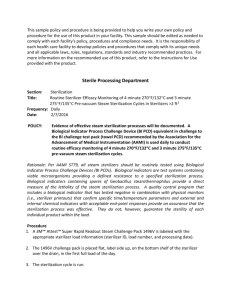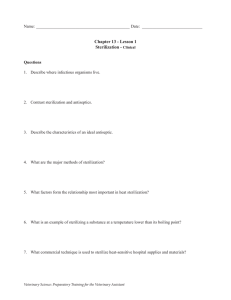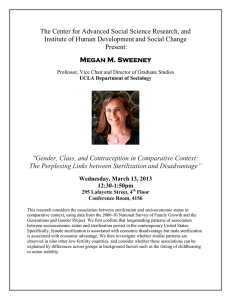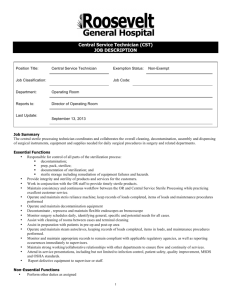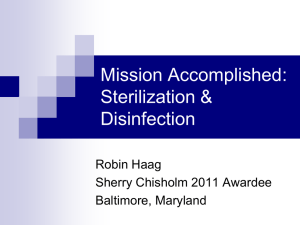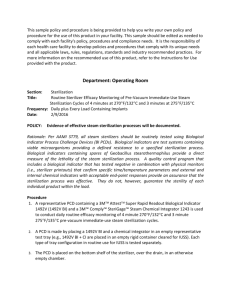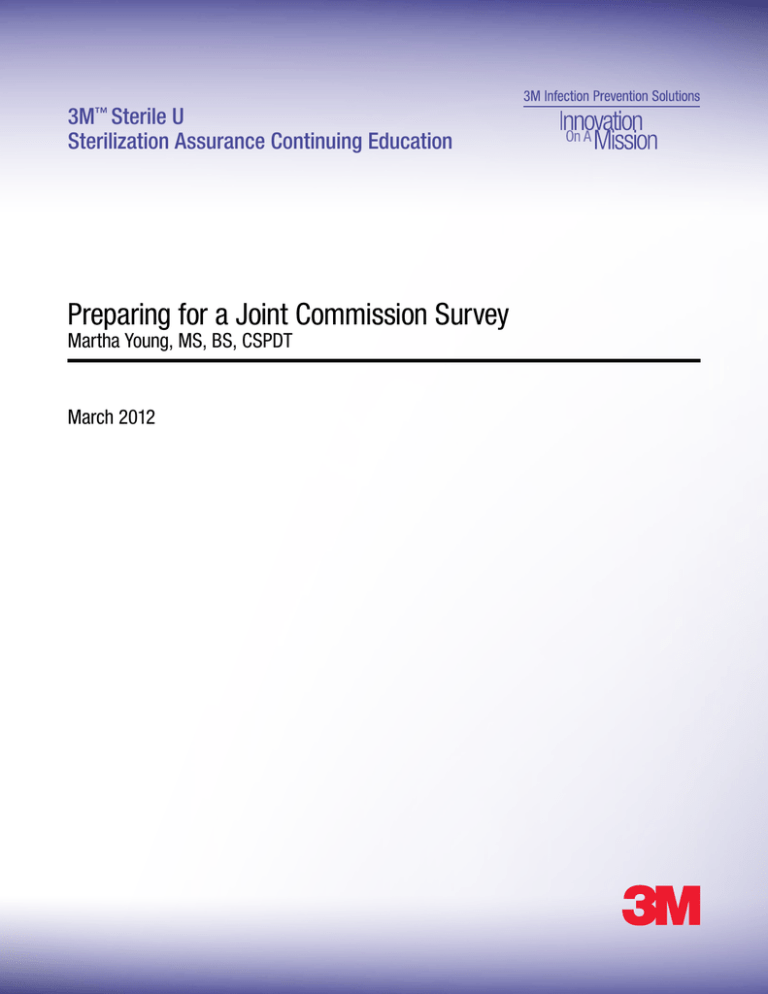
3M™ Sterile U
Sterilization Assurance Continuing Education
Preparing for a Joint Commission Survey
Martha Young, MS, BS, CSPDT
March 2012
S t e r i l i z a t i o n
A ssu r a n ce
C o n t i n u i n g
E d uca t i o n
Objectives
After completion of this self-study activity, the learner will be able to:
1. Identify areas to focus improvement activities to prepare for a Joint Commission survey.
2. Develop or update policies and procedures related to the environment, cleaning process, equipment, housekeeping, sterile storage,
outdates and stock rotation, and quality control of the high-level disinfection and sterilization process based on recommended practices.
3. Develop or update a policy and procedure on loaner instrumentation based on the International Association of Healthcare Central Service
Materiel Management (IAHCSMM) policy and procedure.
4. Develop or update a policy and procedure on immediate-use steam sterilization based on recommended practices and the Multi-society
position statement on Immediate-Use Steam Sterilization.
Test Questions
1
T he Joint Commission (TJC) surveyors are not focusing on the cleaning, disinfection, and sterilization areas within
a healthcare facility.
A. True B. False
2
epartment humidity should ideally be 50% to prevent absorbent material such as wrappers and peel pouches
D
from becoming dried out which could create superheated steam and a sterilization process failure.
A. True B. False
3
se the water quality recommended in the instrument manufacturer’s instructions for use (IFU) for rinsing the
U
instruments during the cleaning process.
A. True B. False
4
ead symbols, dates, and statements on packages so you know which products to use first and which are no
R
longer usable.
A. True B. False
5
6
The water in eye wash stations should be between 13ºC and 38ºC (60ºF and 100ºF).
A. True B. False
7
8
T he lot control numbers of the biological indicator test and control vial should match and be documented.
A. True B. False
9
eleasing implants before the biological indicator (BI) results are known is unacceptable and should be the
R
exception, not the rule.
A. True B. False
10
ir should flow into the soiled/decontamination area (negative pressure)(in) from the preparation and packaging
A
area (positive pressure)(out) to prevent air contaminants from entering the clean areas.
A. True B. False
If recommended by the test strip manufacturer’s instructions for use, perform quality control testing on each new
bottle of MRC/MEC test strips before the strips are placed into routine use.
A. True B. False
ORN recommends the use of containment devices to avoid contamination of instruments processed by
A
immediate-use steam sterilization.
A. True B. False
2
S t e r i l i z a t i o n
A ssu r a n ce
C o n t i n u i n g
E d uca t i o n
Introduction
The Joint Commission (TJC) issued a position statement on
steam sterilization on June 15, 2009.1 In this position statement TJC
said surveyors will be looking more closely into all aspects of the sterilization method or cycle. This includes cleaning and decontamination,
sterilization, storage, and return of instruments to the sterile field. The
surveyors will be observing the process and asking for manufacturer’s instructions for use (IFU) for instruments, the sterilizer, wrapping
or packaging, and chemical and biological indicators. As a result of
TJC position statement a task force was convened of 12 organizations to discuss the specific issue of “flash sterilization.” The result
was a Multi-society position statement on Immediate-Use Steam
Sterilization (formerly known as “flash sterilization).2
In October 2009 TJC made a change to the Infection Control
standard IC.02.02.01 that discussed the responsibility of the organization to reduce the risk of infections associated with medical equipment and devices. This change was first published in the 2010 standard and exists in the 2012 standard.3 The Element of Performance
(EP) 1 was changed to state “Hospital implements infection and
control activities when cleaning and performing low-level disinfection.” Intermediate and high-level disinfection used to be in EP 1 but
they joined sterilization in EP 2. EP 2 addresses intermediate and
high-level disinfection and sterilization of medical equipment, devices,
and supplies. Intermediate and high-level disinfection were moved to
EP 2 to reflect the concern TJC and Centers for Disease Control (CDC)
have for these procedures if done incorrectly.4
As a result of TJC’s emphasis on cleaning, disinfection, and
sterilization the surveyors received in-depth training in 2010 on the
sterilization process through the Association for the Advancement of
Medical Instrumentation (AAMI) based upon the ANSI/AAMI ST79
Comprehensive guide to steam sterilization and sterility assurance in
health care facilities.1 ANSI/AAMI ST79 is now the reference document for surveys.5
To assist you in preparation for TJC survey, the Association
for the Advancement of Medical Instrumentation published in 2011
Sterile Processing in Healthcare Facilities: Preparing for Accreditation
Surveys.” The purpose of this guidance document is to help health
care professionals prepare for an accrediting agency survey as it
relates to the sterile processing of surgical instruments and other
medical devices in health care settings.”6 This is an excellent reference for preparing for surveys for TJC and other organizations.
In May 2011 at the International Association of Healthcare
Central Service Materiel Management (IAHCSMM) annual meeting in
Louisville, KT, the Joint Commission made a presentation on their new
emphasis for 2011 which continues to apply in 2012.
John Eiland, the surveyor who spoke stated that TJC will have
an engineer at every site for 2 days in sterile processing (SP), clinics
etc. for the survey. The surveyor will use the National Fire protection
Agency (NFPA) 101 manual.5 In addition the speaker said to read the
ANSI/AAMI ST79 Section 3 on Design considerations and Section 9
on Installation, care, and maintenance of sterilizers to prepare for the
survey.5 Other comments made in this inservice are from personal
communications with healthcare facilities who have had surveys.
Environment concerns
Temperature and humidity
TJC is interested in knowing what is the temperature and humidity
in the different areas of the department.5,7 ANSI/AAMI ST79 Section
3.3.6.5 and Section 3.3.6.6 discuss the temperature and humidity
requirements for work areas. The temperatures recommended are:
• General work areas – 20ºC to 23ºC (68ºF to 73ºF);
• Decontamination – 16ºC to 18ºC (60ºF to 65ºF);
• Sterilization equipment access rooms – 24ºC to 29ºC (75ºF
to 85ºF);
• Sterile storage and personnel support areas – may be as high
as 24ºC (75ºF).9
Work areas need to be comfortable for workers, especially in
decontamination, and cool and dry enough to minimize bioburden.
Humidity should be between 30% to 60%. The humidity in
sterile storage should never exceed 70%. The ideal relative humidity
is 50% (not below 35%).8 This humidity needs to be maintained to
prevent absorbent material such as nonwoven and woven wrappers
and peel pouches and biological (BIs) and chemical indicators (CIs)
from drying out. If packaging dries out it can create superheated
steam in a steam sterilizer which could lead to a sterilization process
failure. If BIs become desiccated they become more resistant to steam
sterilization which could lead to positive BIs. The response of CIs may
be slowed down as a result of storage in low humidity. Ensure that
all packaging, BIs, and CI are stored according to their instructions
for use (IFU). ANSI/AAMI ST79 Section 8.3.1 states that “packaging
materials should be held at room temperature [20ºC and 23ºC (68ºF
and 73ºF)] and at a relative humidity ranging from 30-60% for a
minimum of 2 hours” before use.8
3
S t e r i l i z a t i o n
A ssu r a n ce
Independent temperature and humidity monitors should be in
each location with the data read and recorded daily by personnel
in order to detect changes in temperature and humidity that could
frequently occur and effect comfort and the result of the sterilization
process.
C o n t i n u i n g
E d uca t i o n
frequency for testing and this information should be sent to the
sterile processing department to add to the documentation records
of temperature and humidity to prepare for a survey and to ensure
correct ventilation at all times.
Separation of dirty/clean/assembly
TJC surveyors have sited healthcare facilities for having a physical setting in which the automated endoscope reprocessor (AER) is in
the same room where the cleaning takes place.7
TJC wants the AER to be located in a different room from cleaning
to prevent cross-contamination or recontamination of the scopes after
processing.5
ANSI/AAMI ST79 Section 3.2.3 addresses functional workflow
patterns.
“The sterile processing department should be designed to separate areas in which contaminated items are received and processed
from areas in which clean items are packaged, sterilized, and stored.
Functional work areas should be physically separated by walls or
partitions to control contaminants generated during the phases of
reprocessing. Work area design also should allow adequate space for
all functions and should promote efficiency by minimizing distances
between related areas.
NOTE – In office-based facilities, physical separation of functional work areas (e.g., the decontamination and clean/sterile areas)
is desirable, but spatial separation could be satisfactory if accompanied by good workflow patterns, airflow characteristics, and work
practices. See Figure 2.”7
If you cannot physically separate the two activities in the endoscopic area then do a risk analysis and determine what changes
you can make to the entire process to prevent cross-contamination
or recontamination of the endoscopes and be prepared when TJC
surveyor arrives. Improving functional separation through airflow
patterns or separation of activities are some suggestions in ANSI/
AAMI ST79.8 The results of a survey may present an opportunity for
the modification or construction of a new area that meets the recommended practices for separation of contaminated endoscopes from
processed and stored endoscopes.
Departments have also been cited by TJC surveyors because
the door and pass through window between clean and dirty was
open.7 ANSI/AAMI ST79 Section 3.2.3 recommends a “pass-through
window that is at equal counter height between the decontamination
and clean processing areas.”8 Both the door and pass through window
need to be closed to maintain the airflow needed to prevent contaminants from escaping to the clean side.
The objective of separation of dirty/clean/assembly is to
limit environmental contamination by containment which limits the
bioburden on devices to be high-level disinfected or sterilized.
Water quality
TJC is concerned about water quality because it is important in
the cleaning of medical devices.5,7 ANSI/AAMI ST79 Section 7.5.4
discusses the importance of water quality in the rinsing of instruments
whether they are cleaned manually or mechanically. Devices “should
be thoroughly rinsed to ensure that loosened debris and detergents
are adequately removed.”8 Tap water can be used first to ensure the
use of copious volumes of water but the final water rinse should be
done with treated water according to the medical device manufacturer’s IFU. The IFU may recommend deionized, distilled, or reverse
osmosis (RO) water with the objective of minimizing staining and
contamination of instruments with microorganisms from the tap water
source. To eliminate pyrogens from the final rinse, “regular maintenance of the water treatment process is essential.”8
Ventilation (air flow and air exchanges)
TJC surveyors have been checking the air flow rate between
the decontamination/soiled area and preparation and packaging at
the pass through window using a facial tissue.7 Healthcare facilities
have been cited because the air flow was not correct. Air should flow
into the soiled/decontamination area (negative pressure)(in) from the
preparation and packaging area (positive pressure)(out) to prevent
air contaminants from entering the clean areas. The air in the areas
under negative pressure “should be exhausted to the outside via a
nonrecirculating system.”8 This information is discussed in ANSI/
AAMI ST79 Section 3.3.6.4.8
Negative air flow (in) with a minimum of 10 air exchanges per
hour should occur in the following areas:
• Soiled/decontamination;
• Sterilizer equipment access;
• Sterilizer loading/unloading;
• Restrooms/housekeeping.8
Positive air flow (out) with a minimum of 10 air exchanges per
hour should occur in the following areas:
• Preparation and packaging;
• Textile pack room.8
Clean/sterile storage should be a positive air flow (out) with a
minimum of 4 air exchanges per hour.8
Ventilation controls bioburden and environmental contaminants
to ensure the effectiveness of the sterilization process. TJC surveyors
have also asked if engineering provides the department with reports
showing airflow rates.7 The facility should determine an appropriate
4
S t e r i l i z a t i o n
A ssu r a n ce
Traffic patterns and related attire if appropriate
TJC surveyors are observing traffic patterns and related attire in
sterile processing.5
ANSI/AAMI Section 3.2.4 discusses that traffic in decontamination, preparation and packaging, sterilization processing, sterile
storage, and distribution should be restricted to authorized personnel.8
Policies and procedures should specify criteria for authorized entry,
movement and attire with the objective of preventing microorganisms
from being carried into the area and to protect personnel and visitors
from microorganisms present on contaminated items being processed
in the decontamination area. If entry is necessary, personnel protective
equipment (PPE) is required (Section 4.5). The PPE worn will depend
on the area accessed and activities performed. At a minimum clean
uniforms provided by the facility should be worn and not uniforms
worn in from the outside. Other PPE can include protective gloves,
protective attire, eye protection, and face masks.
C o n t i n u i n g
E d uca t i o n
Eye wash stations are required by OSHA for immediate use in
locations where chemical such as cleaning agents, disinfectants,
and low temperature sterilization chemicals such as ethylene oxide,
hydrogen peroxide, and ozone are used. The eyewash station should
be marked with a highly visible sign and employees should be able
to reach the station in 10 seconds. If a strong acid or strong caustic
solution is used the eyewash station should be immediately adjacent
to the hazard. The eyewash station should be maintained according
to the manufacture’s IFU and tested routinely for proper operation. To
be prepared for a JC survey the temperature should be checked and
documented.
Other
TJC surveyors have also checked to see if you have:
• A disaster plan;
• E vacuation procedures for areas in which ethylene oxide sterilizers are used;
• Emergency exit maps that match and are consistent;
• Fire extinguishers that are not blocked;
• S taff that know where fire alarm pull stations are located;
• A djustable (ergonomics) workstations;
• A bility to weigh trays (check to ensure ≤25 pounds) and have
a log to document the weight;
• Peg boards that are not made of absorbable surfaces (paint to
ensure not absorbable).5,7
Eye wash stations
TJC expects the water temperature in the eye wash stations to be
between 13ºC and 38ºC (60ºF and 100ºF). ANSI/AAMI ST79 Section
3.3.8 addresses emergency eyewash/shower equipment. No water
temperature is discussed but it states that “ANSI Z358.1 requires that
eyewash units provide a minimum of 0.4 gallons per minute continuously for at least 15 minutes, that they are designed to flush both eyes
simultaneously, and that they have a “hands-free, stay open” feature
once activated.”8
Cleaning process
Cleaning is a top priority for TJC surveyors. They have asked
healthcare facilities if loaner instruments are received at least 24
hours ahead of time for cleaning and processing and whether loaner
instruments are processed in the same manner as other instruments
in all areas of the healthcare facility following the instrument manufacturer’s IFU.7 The IAHCSMM Sample Policy & procedure for Loaner
Instrumentation recommends that healthcare facilities require receipt
of loaner trays at least two (2) business days prior to the scheduled
case and three (3) business days for first-time vendor-loaned sets
for inservicing, inspecting and processing.11 This is considered the
amount of time required to properly process the instruments using the
manufacturer’s IFU.
TJC surveyor may ask for a copy of the manufacturer’s IFU
and observe the cleaning process, including PPE.7 The surveyor
may also observe if rigid containers are being broken down and
washed according to the manufacturer’s IFU.7 Most manufacturers
recommend that the filter retention plates be removed from the
container for washing. TJC surveyor may observe if you are using the
correct amount of cleaning agent and diluting it properly.7 This may
require the use of a graduated cylinder to determine if the amount
of cleaning agent dispensed is correct and a marking of the sink to
ensure the correct amount of water is added.
ANSI/AAMI ST79 Section 7 Cleaning and other decontamination processes is an excellent resource for information on the cleaning
process.8 Follow the instrument, mechanical cleaning equipment,
cleaning agent, and cleaning tools instructions for use to ensure
proper cleaning of all items. And remember that the cleaning process
needs to be the same in the OR and ASC as it is in SP. There are no
short cuts and there are monitoring tools available to assist in determining if the cleaning process is effective. These tools are discussed
in ANSI/AAMI ST79 Annex D.8
5
S t e r i l i z a t i o n
A ssu r a n ce
C o n t i n u i n g
E d uca t i o n
Equipment
TJC is interested in the use/function, recalibration, ongoing/
periodic cleaning and maintenance of equipment, including contractor
servicing.5 ANSI/AAMI ST79 Section 9 discusses Installation, care,
and maintenance of sterilizers and is the section used for this part of
the survey. This section covers the care and maintenance procedures
applicable to steam sterilizers which are important to minimize sterilizer downtime and prevent sterilizer malfunctions. “The manufacturer’s
maintenance schedule and procedures should be followed, whether
the sterilizer is new, remanufactured, refurbished, or reconditioned.”8
The manufacturer’s instruction manual should be available to internal
and external personnel who may perform the required services.
Routine care of sterilizers is discussed in ANSI/AAMI Section
9.4. “Sterilizers should be inspected and cleaned daily according to
the manufacturer’s written instructions (see 9.2).”8
Ongoing daily care and cleaning includes the following components of the sterilizer:
• Recording charts;
• Printers;
• Printer ribbons;
• Marking pens and ink;
• Door gaskets;
• Chamber drain screen;
• Internal chamber, and;
• External surfaces.8
Weekly or periodic care of components of the sterilizer should be
performed as recommended in the sterilizer manufacturer’s written
instructions for use.
Preventive maintenance should be done according to the sterilizer manufacturer’s written instructions for use and by a qualified
individual. ANSI/AAMI ST79 recommends in Section 9.5:
“Simple charts showing the location and replacement dates of
components will show trends in deterioration and provide a framework
of a preventive maintenance program. The maintenance program may
be in-house or contracted with the equipment manufacturer or other
qualified service company. Preventive maintenance and repair records
should be retained (see 9.7).8
Calibration should only be performed by qualified personnel to
ensure effective and reliable sterilization (see Section 9.6).8
It is important to document what and when preventive maintenance and calibration was performed by either internal or external
personnel from the sterilizer manufacturer or a contractor service.
“These records can be either in paper or electronic format and should
be kept for each sterilizer (see ANSI/AAMI ST79 Section 9.7)”7 The
documentation “should be maintained by the supervisor responsible
for the equipment, by the hospital engineering staff, by the service
person or organization that performed the servicing, and/or by
whoever else is deemed appropriate by the health care facility.”8
Documentation should be kept for the life time of the sterilizer.
Maintaining documentation will assist sterile processing in trouble
shooting steam sterilization processes. Other departments will need
the documentation “to identify the equipment and to establish a
continuous history of all scheduled and unscheduled service.”8
Housekeeping
TJC will survey the cleanliness of the department.5 They are
asking about the frequency of departmental cleaning including:
• Daily versus deep cleaning;
• Behind closed doors and under racks;
• Hidden corners and high level flat spaces;
• Behind and around automatic cleaning equipment;
• Sterilizers access room including the tops of sterilizers, and;
• Is the “dirty” room clean? 5
ANSI/AAMI ST79 Section 3.4 briefly discusses housekeeping
procedures. Housekeeping procedures in sterile processing “should
be the same as those used to clean operating and delivery rooms and
should ensure a high level of cleanliness at all times.” This includes:
• Cleaning the floors and horizontal work surfaces at least daily;
• Cleaning on a regular scheduled basis and more often if
needed:
– Walls;
– Storage shelves;
– A ir intake and return ducts;
• Replacing stained ceiling tiles and repair leaks that caused
stain, and;
• Cleaning lighting fixtures or covers every 6 months.8
Separate housekeeping tools should be used for decontamination and clean areas to avoid transferring contaminants from “dirty” to
“clean” areas and surfaces. Clean up your act because TJC surveyor
will be wearing white gloves.
6
S t e r i l i z a t i o n
A ssu r a n ce
C o n t i n u i n g
E d uca t i o n
Sterile storage
TJC is interested in the security of storage areas, how cardboard
boxes and shipping containers are handled, that items are stored in
sterile storage 18 inches below the bottom of the deflector plate of
sprinklers, and the bottom shelf of each rack has a solid bottom.5,7
ANSI/AAMI ST79 discusses sterile storage in Section 8.9. Sterile
items should be stored at least:
• 8 to 10 inches above the floor;
• 18 inches below the ceiling or level of the sprinkler heads;
• 2 inches from outside walls.9
If the bottom shelf of an open-shelf (wire) cart is used there should
be a physical barrier between the shelf and traffic or housekeeping
activities to prevent contamination of the items. “Outside shipping
containers and corrugated cartons should not be used as containers
in sterile storage areas. (See also 5.2.1)”8 Shipping containers have
been exposed to potentially high microbial contamination and corrugated cartons generate and are reservoirs for dust. Traffic should be
restricted to authorized personnel wearing appropriate attire. (ANSI/
AAMI ST79 3.2.4 and 4.5) 8 The objective is to protect the sterility of
stored products by controlling the environment and handling of the
sterile item (i.e., do not crush, bend, compress or puncture).
Outdates and stock rotation
TJC is interested in outdating and stock rotation and the ability of
employees to read the symbols on sterile purchased items to ensure
they are not used beyond the date listed by the manufacturer of the
product.5,7
ANSI/AAMI ST79 Section 8.9.3 discusses shelf life. “There
should be written policies and procedures for how shelf life is
determined and how it is indicated on the product.”8 Train employees
to read symbols, dates, and statements on packages so they know
which products to use first and which are no longer usable. Also train
personnel to inspect packages that say “Do not use if package is open
or damaged” before the package is released.
Quality control
Test strip and chemical monitoring devices
TJC surveyor is interested in seeing the data from the quality
control (QC) testing of the MRC/MEC test strips used to measure the
minimum recommended concentration/minimum effective concentration (MRC/MEC) of the high level disinfectant.5,7 This testing should be
done according to the test strip manufacturer’s IFU but is not required
by all test strip manufacturers. In general, the testing is done when
a new bottle of strips is opened. Pass and fail solutions are prepared
and the strips need to correctly detect the results of both solutions
before the new bottle of strips can be placed into routine use. ANSI/
AAMI ST58 Section 9.3.3 discusses solution test strips and chemical
monitoring devices:
“Health care personnel should use the appropriate test strip or
chemical monitoring device to test the LCS/HLD solution. The solution
should be tested before each use (ASGE and SHEA, 2003). If the test
strip or chemical monitoring device indicates that the concentration of
the active ingredient is inadequate, the solution should not be used.”9
TJC surveyors will also check the shelf life of the MRC/MEC test
strips and the high-level disinfectant and they will ask for the QC test
strip data so you need to document that testing.8
Biological (BI) and chemical indicators (CI)
TJC surveyor will be checking to ensure that:
• BI used is correct for the cycle being tested (follow BI manufacturer’s IFU);
• L ot numbers of the BI test and control vials match and are
documented.5,7
They will also ask how often do you run BIs and Bowie-Dick
tests, will check the BI records for all sterilization processes in both
SP and the OR, and will ask to see documentation for the last recall.8
ANSI/AAMI ST79 discusses the routine testing procedure for
steam sterilizers, including the correct BI process challenge device (BI
PCD) and the use of controls in Section 10.7.8
For controls:
“Each day that test BIs are run, at least one BI that is from the
same lot and that has not been exposed to the sterilant should be
incubated as a control in each incubator to verify the presterilization
viability of the spores, the ability of the media to promote growth of the
test spores, and the proper incubation temperature.”8
7
S t e r i l i z a t i o n
A ssu r a n ce
ANSI/AAMI ST79 Section 10.5.3.2 states steam sterilizers
should be monitored routinely with a BI PCD weekly, preferably daily
(each day the sterilizer is used).8 If a steam sterilizer is designed to be
used for multiple types of cycles then:
• e ach type of cycle should be routinely tested because each
cycle creates a different challenge to air removal and steam
penetration
– g ravity-displacement at 132°C to 135°C [270°F to
275°F];
– g ravity-displacement at 121°C [250°F];
– d ynamic-air removal at 132°C to 135°C [270°F to
275°F];
– fl ash or immediate-use at 132°C to 135°C [270°F to
275°F];
– fl ash or immediate-use with single wrapper or other
packaging.8
A note states that if you are running both a 4 and a 10 minute
dynamic-air removal sterilizer at 132°C to 135°C [270°F to 275°F],
then only the shortest sterilization time needs to be tested.8
In addition for implants:
“BIs within PCDs should be used to monitor every load containing
implants (see 10.6.1); implants should be quarantined until the results
of the BI testing are available (CDC, 2008).8
ANSI/AAMI ST79 Section 10.6.3 discusses:
“Releasing implants before the BI results are known is unacceptable and should be the exception, not the rule. When documented
medical exceptions dictate (e.g., the need for trauma-related orthopedic screw-plate sets), it could be necessary to release an implantable device before the BI results are known. In this case, the release
of the device before the BI results are known should be documented;
the BI result obtained later should also be documented. (See Annex L
for examples of an implant log and an exception form).”8
C o n t i n u i n g
E d uca t i o n
TJC wants the exception form used and a department of surgery
policy with multidisciplinary input in place that addresses who can
authorize early release of implants.5 TJC suggests it be a surgeon but
that a signature is not required on the exception form.5 Many hospitals
do require the surgeon’s signature to stress the importance of making
this decision to release implants before the BI results are available.
The use of BI PCDs for steam sterilizer qualification testing is
discussed in ANSI/AAMI ST79 Section 10.8.8
In ANSI/AAMI ST79 Section 10.7.6 it states a Bowie-Dick test
“should be carried out each day the sterilizer is used before the first
processed load.”8 ‘The Bowie-Dick test also should be carried out
during sterilizer qualification (10.8).”8
ANSI/AAMI ST79 also addresses recall in Section 10.7.5 entitled Actions to take when biological indicators, chemical indicators, or
physical monitors indicate failure in a sterilization process.8
“If the cause of the failure is immediately identified (usually operator error) and confined to one load or one item in the load (i.e., an
item with a nonresponsive internal CI), the cause of the failure should
be corrected and the load should be reprocessed. If the cause of the
failure is not immediately identified, the load should be quarantined,
and all loads back to the last negative BI should be recalled. Items
in those loads should be retrieved, if possible, and reprocessed (see
10.11). The sterilizer in question should be taken out of service for
further investigation of root causes. See Figure 12 and Table 8 for
guidance on how to conduct this investigation.”8
Following the recommended practices for usage of BIs and CIs
and quarantining implants until the BI results are available will ensure
the effectiveness of the sterilization process and improve patient
safety.
8
S t e r i l i z a t i o n
A ssu r a n ce
C o n t i n u i n g
E d uca t i o n
Immediate-use steam sterilization (IUSS)
IUSS “is broadly defined as the shortest possible time between a
sterilized item’s removal from the sterilizer and its aseptic transfer to
the sterile field. Immediacy implies that a sterilized item is used during
the procedure for which it was sterilized in a manner that minimizes
its exposure to air and other environmental contaminants.”2 TJC has
cited healthcare facilities for not using containment devices for IUSS.7
AORN says in Recommendation IV.a.2. for flash or IUSS to avoid
contamination of the items during transportation to the sterile field:
“Items are placed in a closed sterilization container or tray, validated for flash sterilization, in a manner that allows steam to contact
all instrument surfaces.”10
TJC has asked if items processed by IUSS have been tracked
to the patients.7 ANSI/AAMI ST79 Section 10.3 states “Flash sterilization of implantable devices is not recommended; however, if it is
unavoidable, full traceability to the patient should be maintained.”8:
This traceability is especially important because “the consequences
of implant-related infections are particularly severe and result in
increased morbidity and mortality.”8
Certification
Surveyors have asked facilities to point out who is certified
and some surveyors have congratulated those individuals.7 TJC has
not cited healthcare facilities for not having certified employees but
TJC understands the importance of certification and so should your
healthcare facility. ANSI/AAMI ST79 Section 4.2 recommends that
“all personnel performing sterile processing activities be certified as
a condition of employment. At a minimum, all such personnel should
successfully complete a central service certification examination
within two years of employment and should maintain that certification
throughout their employment.”8 Certification can be obtained from:
• Certification Board for Sterile Processing and Distribution (CBSPD)
148 Main Street, Suite C-1, Lebanon, NJ 08833
800-555-9765
http://www.sterileprocessing.org
• International Association of Healthcare Central Service
Materiel Management (IAHCSMM)
213 Institute Place, Suite 307, Chicago, IL 60610
312-440-0078
http://www.iahcsmm.org.
Orientation and on-the-job training, and continuing education are important to prevent operator errors and protect employees
from potential safety hazards and ensure policies and procedures are
adhered to. TJC requires documentation of training and continuing
education. Certification is a method to determine initial competency.3
9
S t e r i l i z a t i o n
A ssu r a n ce
C o n t i n u i n g
E d uca t i o n
Summary
Following the recommended practices from AAMI, AORN, and
CDC and being aware of what TJC is looking for in a survey will help
you prepare for TJC survey and more importantly improve patient care.
References
1. The Joint Commission. Updated: The Joint Commission’s position on steam sterilization. Joint Commission Perspectives. July
2009:29(7):8 and 11. Accessed Feb 12, 2012 at: http://www.
jointcommission.org/joint_commission_online_july_20_2011/
2. Multi-Society Immediate-use steam sterilization statement.
Accessed Feb 20, 2011 at http://www.aami.org/publications/
standards/ST79_Immediate_Use_Statement.pdf
3. The Joint Commission. 2012 Hospital Accreditation Standards
(HAS).
4. Centers for Disease Control (CDC). Guideline for Disinfection and
Sterilization in Healthcare Facilities, 2008. Available free at: http://
www.cdc.gov/hicpac/pubs.html
5. Eiland, John E, Surveyor, The Joint Commission. Joint Commission
presentation at IAHCSMM annual meeting in May 2011.
Presentation available on flash drive provided to attendees. Martha
Young attended presentation.
6. Association for the Advancement of Medical Instrumentation. Sterile
Processing in Healthcare Facilities: Preparing for Accreditation
Surveys. 2011.
7. Personal communication with healthcare facilities who have had
surveys.
8. Association for the Advancement of Medical Instrumentation.
Comprehensive guide to steam sterilization and sterility assurance
in health care facilities. ANSI/AAMI ST79:2010/A2:2011.
9. Association for the Advancement of Medical Instrumentation.
Chemical sterilization and high-level disinfection in health care
facilities. ANSI/AAMI ST58:2005.
10. Association of perioperative Registered Nurses (AORN).
Recommended Practices for Sterilization in the Perioperative
Practice Setting in AORN Perioperative Standards and
Recommended Practices. 2012.
11. IAHCSMM Sample Policy & Procedure for Loaner Instrumentation
and IAHCSMM Position Paper on the Management of Loaner
Instrumentation, June 2011
A vailable free at:
http://www.iahcsmm.org/CurrentIssues/Loaner_
Instrumentation_Position_Paper_Sample_Policy.html
10
S t e r i l i z a t i o n
A ssu r a n ce
C o n t i n u i n g
E d uca t i o n
Answers
Martha Young, BS, MS, CSPDT
1.B
2.A
3.A
4.A
5.A
6.A
7.A
8. A
9.A
Martha Young, BS, MS, CSPDT, is president of Martha L. Young, LLC, providing
SAVVY sterilization solutions to healthcare manufacturers and facilities and a
consultant for 3M. She retired from the
3M Infection Prevention Division, St.
Paul, MN in 2009 after 31 years and
has over thirty years of experience in
the specialty area of cleaning/disinfection and sterilization. Ms.
Young has lectured around the world, has numerous publications
on infection prevention with an emphasis on how to improve the
performance of the sterilization process, and writes a quarterly
column for OR Manager. She is a member of IAHCSMM, AORN
(Past Professional/Practice Issues Chair for AORN Speciality
Assembly for Sterilization Processing and Materials Management
from 2006-2010), APIC and a certified Central Sterile Processing
and Distribution Technician. Additionally, Ms. Young is the APIC
representative to AAMI and a voting member of several AAMI
working groups developing recommended practices. In 2007 HPN
acknowledged her as one of the “30 Pros Worth Knowing’ who are
the Most Influential in Healthcare Sterile Processing. Ms.Young can
be reached at marthalyoung1@aol.com.
11
S t e r i l i z a t i o n
A ssu r a n ce
C o n t i n u i n g
E d uca t i o n
Sterile Process and Distribution CE Information
CE Applicant Name:
City:
Address:
State:
The CBSPD (Certification Board for Sterile Processing and
Distribution) has pre-approved this inservice for 1.5 contact hours
for a period of five (5) years from the date of publication. Successful
completion of the lesson and post test must be documented by
facility management and those records maintained by the individuals
until re-certification is required. DO NOT SEND LESSON OR TEST
TO CBSPD.
For additional information regarding Certification contact: CBSPD,
Inc. 148 Main St., Lebanon, NJ, 08833 or call 908-236-0530 or
1-800-555-9765 or visit the website at www.sterileprocessing.org.
Zip Code:
IAHCSMM has awarded 1.5 contact hours for completion of this
continuing education lesson toward IAHCSMM recertification.
Nursing CE Application Form
This inservice is approved by the California Board of Registered Nurses, CEP 5770 for 1 contact hour. This form is valid up to five (5) years
from the date of publication.
6. S ubmit this form and the answer sheet to:
3M Infection Prevention
Attn: HC4160
RR Donnelly Fulfillment Services
585 Hale Avenue North
Oakdale, MN 55128-9935
1. Make a photocopy of this form.
2. Print your name, address and daytime phone number and
position/title.
3. Add the last 4 digits of your social security number or your nursing
license number.
7. F or questions please call the 3M Healthcare helpline: 1-800-228-3957.
4. Date the application and sign.
8. P articipants who score at least 70% will receive a certificate of
completion within 30 days of RR Donnelly’s receipt of the application.
5. Answer the true/false CE questions. Keep a copy for your records.
Application
Please print clearly or type.
Name:
Daytime phone: (
Mailing Address:
Position/Title:
City:
Social Security or
Nursing License Number:
State:
Zip Code:
Date application submitted:
Country:
Offer expires
Signature:
March 2017
Infection Prevention Division
3M Health Care
3M Center, Building 275-4E-01
St. Paul, MN 55144-1000
U.S.A.
1 800 228-3957
www.3M.com/infectionprevention
Please recycle. Printed in U.S.A.
3M is a trademark of 3M.
© 3M 2012. All rights reserved.
12
)

